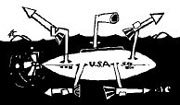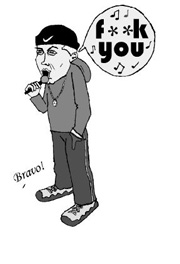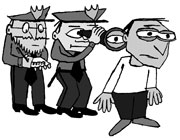LAST THURSDAY, the faithful gathered once again by the fences of the U.S. Navy’s submarine base at Bangor, where the U.S. stores 1,536 nuclear warheads—enough firepower to turn the planet into a new asteroid belt. It was the 56th anniversary of the U.S. bombing of Nagasaki, Japan, the last time a nuclear weapon was deployed in war.
Each year, right around the anniversaries of the bombings of Hiroshima and Nagasaki—and at two or three other points in the year—supporters of the Ground Zero Center for Nonviolent Action faithfully gather at Bangor’s gates; sometimes in the hundreds, more often in the dozens. They are the anti-nuclear hard core: the pacifists, the Catholic worker types, the committed activists. They are appalled at the violence implicit in America’s 18 Trident submarines, the deadliest weapons ever devised.
Eight of them—each with 24 missiles and 192 warheads, a single warhead far more powerful than the blast that leveled Hiroshima—are based in Kitsap County, a few miles west of Seattle. The Navy is currently spending at least $6.5 billion in tax dollars to upgrade the missiles. While the folks at Ground Zero pray, meditate, protest, and resist, over three million Western Washingtonians live their lives nearby without giving the whole thing much thought.
It wasn’t always this way. The ascendancy of Ronald Reagan launched a movement that, only 15 or so years ago, was a force in mainstream American politics. Back then, the protests at Bangor were both enormous and so effective that the government stopped running its nuclear-laden “white trains.” The freeze and disarmament movements, both here and in Europe, were almost entirely driven by millions of people’s horrified fear of Reagan and his deranged “winnable nuclear war” rhetoric. Among activists, Aug. 69 became something of a national holiday, often celebrated with either family picnics at the local lantern-float ceremony or fence climbing at the nearest weapons facility.
When it became clear that the military-industrial complex was not so easily dislodged, the movement fizzled. But the threat never went away—even when the Cold War did. Today, the U.S. arsenal, though reduced, still contains insane numbers of insanely destructive weapons pointed at our allies and trading partners (especially Russia and China) and still on high alert. Worse, we now have in the White House a president who trumpets noisily what previous administrations pursued quietly: the expansion, in numbers and especially capacity, of a first-strike armada that explicitly aspires to rule the world through nuclear blackmail. National Missile Defense is only a very small, and not especially important, piece of a long-term Pentagon and U.S. Space Command strategy to encircle the globe with first-strike weaponry.
DR. STRANGELOVE AND DUBYA
Today, Seattle still holds a quiet Hiroshima commemoration at Green Lake each year, and Ground Zero anti-soldiers on. But otherwise, the nuclear anniversaries are largely forgotten. Reagan was bad; in many ways, Dubya is worse, having handed over command of the Pentagon, NASA, and the U.S. Space Command to Dr. Strangelove’s brood. But unlike 20 years ago, no outcry has emerged.
If we were worried that, in Ronald Reagan, we had a commander in chief sufficiently stupid, arrogant, and detached from reality to use these weapons, George W. Bush doesn’t exactly inspire confidence. But few people seem aware that he has the power to destroy the world instantly. Perhaps, 56 years after Hiroshima and Nagasaki, too few can remember the horror—it all seems so unreal. It’s not much of an exaggeration to say that I would not be writing this column for Seattle Weekly each week were it not for the bombing of Hiroshima.
While visiting the family of my then-wife—who is Japanese and hails from the area—we made our pilgrimage to the site of the nuclear detonation and to the nearby museum and memorials. For anyone who has never been there and gets the opportunity: Go. It is an incredibly powerful and moving experience , both for the suddenness and totality of the catastrophe and the fact that the weapons that caused it are so much more enormous and plentiful today. Hiroshima inspired me to help with translating when, a few months later, some hibakusha (atomic blast survivors) came through Houston, and from there, the descent into my ongoing career of political agitation was pretty quick.
The best rebuttal to today’s nuclear complacency still lies in the heart of downtown Hiroshima—at the Atomic Bomb Dome, in the paper cranes and searing photographs of the dead and the living dead. It haunts me to this day. And if it is true that we’re doomed to repeat the history that we have forgotten, I listen to George W. Bush, Donald Rumsfeld, Joseph Biden, Colin Powell, and the rest of America’s circle of imperial military mandarins, and I look toward Kitsap County, and I am very, very afraid.







